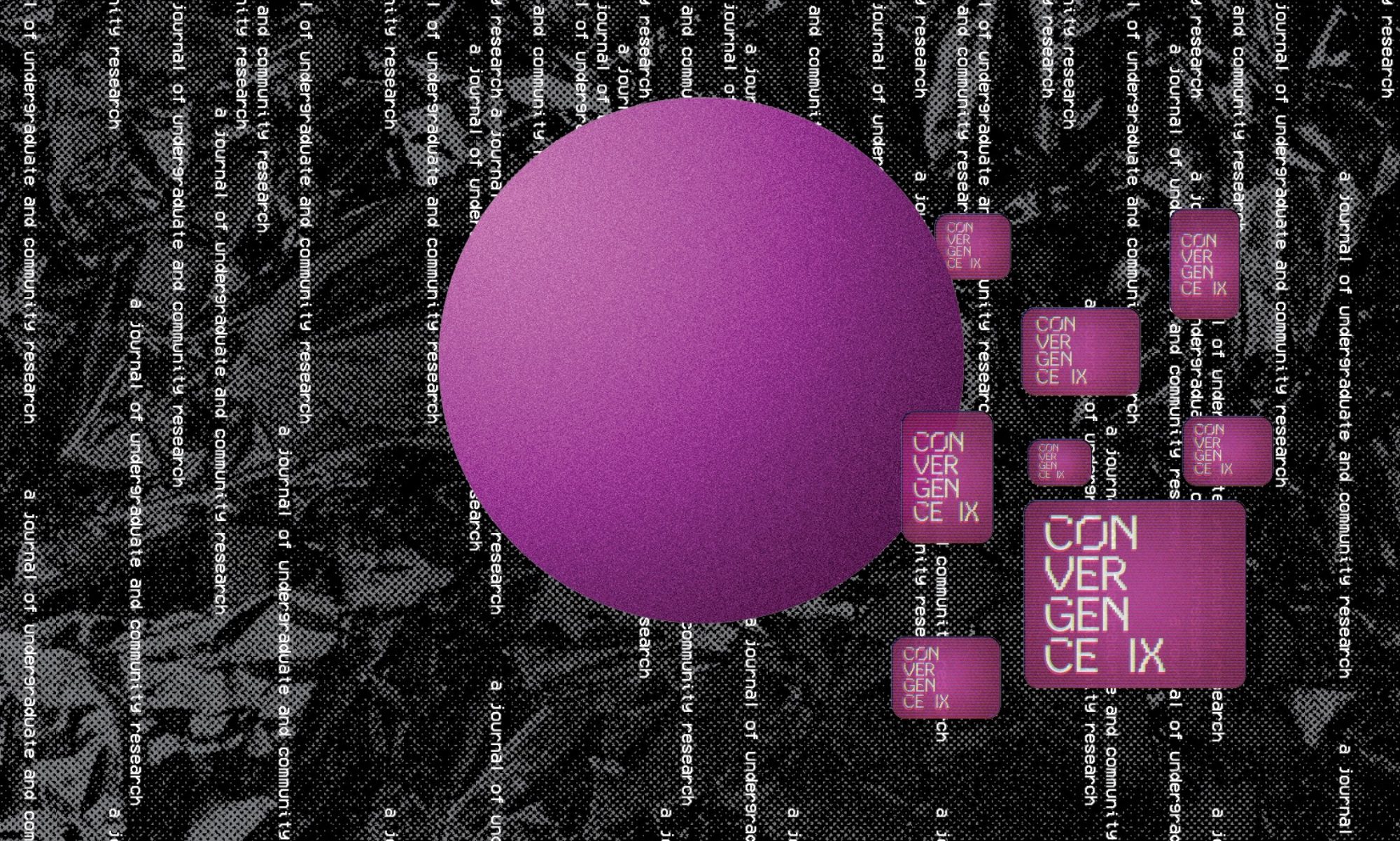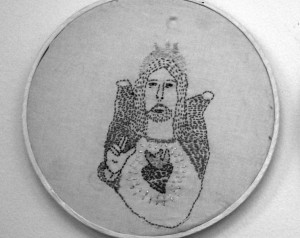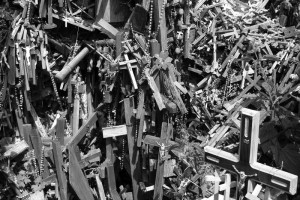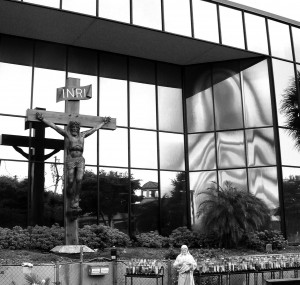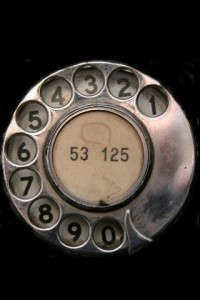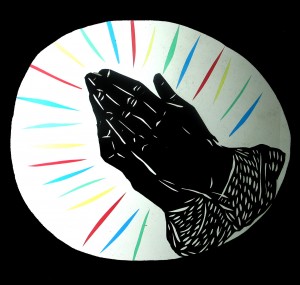(this is an excerpt)
By Kerri Flannigan,
Undergraduate student of Studio Arts at Concordia University
Introduction:
Recently I’ve been embroidering stories of growing up in religious surroundings. Stitching becomes a form of meditation, a reflecting and releasing.
Depictions of my mouth washed with soap to cleanse away dirty words. The bible my mom demanded I swear on that I wasn’t dating anyone. (I was). The exorcism I witnessed in my camp cabin when I was 12. Images of guilt, sexual shaming, censorship, and rebellion. For me, depicting the sacred is its undoing, releasing the power these memories still hold over me.
Art comes into contact with the sacred in so many ways.
Art depict the sacred
It resists
It appropriates
It queers
It creates
It undoes the sacred through its own representation
and finds the sacred in the mundane
In Christian art, depicting heaven and hell, god and the devil, was speaking to a need to give immaterial divinity a material presence.
Heaven isn’t a physical place, but a condition.
But as the church figured out, it was impossible for people to imagine being without a location or a body.
There was a need to depict heaven and hell as real to be able to understand/desire/fear them.
Hell often becomes an impetus for believing, and in some cases as means of social control or as a justification for colonization.
Art That Responds to the Material Violence in the Name of the Sacred:
There are no words to capture the impact of violence enacted in the hands of the church. But one example is the aggressive assimilation by church-run residential schools, which tore over 150,000 native, Inuit, and Métis children from their homes and left a legacy of abuse and trauma. Many have responded to this violence through art. Depicting, witnessing, resisting, exposing, and reflecting on this trauma.
Cathy Busby’s We Are Sorry, contains two 20’ x 45’ banners containing excerpts from the 2008 landmark apologies to aboriginal people for Indian residential schools in Canada and the stolen generations in Australia.
The apologies were of major significance, yet occurred in fleeting moments. In We Are Sorry, Busby attempts to give the apologies a renewed and sustained presence.
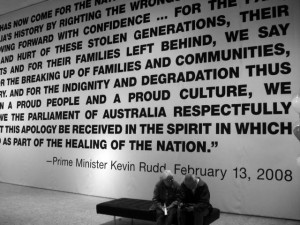
Artists Who Appropriate the Sacred:
Naji al-Ali, renowned Palestinian cartoonist, was born in Galilee and grew up in a refugee camp in Lebanon.
Naji al-Ali worked for a newspaper and created his character Hanthala. Hanthala is in the foreground of Naji al-Ali’s cartoons, witnessing and speaking out against Israel, U.S. imperialism, and corrupt Arab regimes.
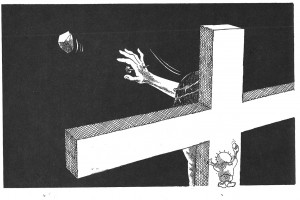
Naji al-Ali’s art work uses divinity as a source of strength rather than as a role of colonizer or oppressor. He says Jesus is a Palestinian and dreams of returning to his home. He depicts Jesus throwing stones in support of the intifada.
Naji al-Ali was shot and killed in London. He was 50 years old. He remains a hero in the Arab world, and Hanthala, a symbol of Palestinian resistance.
The Perversion of Divinity:
What does it mean to take the imagery of oppression and appropriate it?
Artists explore this question in the subversion of re-interpretations of religious icons, for example in the practice of artists’ queering of saints and religious icons. This act asserts the right to personally interpret and transform icons to represent one’s own place in the world. To counter the mass of imagery of white, sexist, hetero-normative subjects. To insert counter-narratives to religious imagery. Women as strong. Saints as Homos. For example.
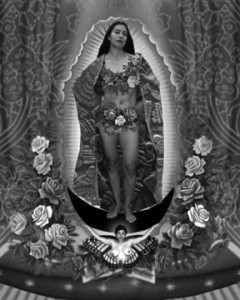
These endeavors always leave a wake of conflict by those unable to reconcile any interventions of sacred images. Alma Lopez’s feminist and lesbian re-interpretations of the Virgin of Guadalupe resulted in violent protest, national debates, censorship, hate mail, and death threats.
Undoing the Sacred Through its Own Depiction:
Bible stories have been depicted for a long time but they’ve always been cleaned up and selectively portrayed.
MC Gaines, who claims to have invented the comic medium, published, Picture Stories from the Bible. When he died his son took over the business and began making these edgy and sexy crime and horror comics instead.
The Catholic Church opposed comic books for some time and in the 1940s even sponsored the public burning of comics. But eventually they came around, recognizing the form’s appeal to young people. Their comics were, of course, cleaned-up and wholesome edits of the Bible.
In 2009 Robert Crumb illustrated The Book of Genesis. The Book of Genesis has a typical western depiction of god, who Crumb says looks like his father. Also, all the main women; Eve, Sarah and Rachel are said to look like Crumb’s wife, Aline. It makes for some odd reading.
Genesis is the story of God’s relationship with fallen humanity. Murder, incest, slavery, and nudity abound. People were scandalized by the Book of Genesis even though Crumb didn’t go out of his way to be graphic. Crumb’s illustrated Genesis, the chapter of the bible I read when I was seven years old, has a warning on its cover: “Adult Supervision Recommended for Minors.” The literal depiction of the bible became the profane.
Finding the Sacred in the Mundane:
Simulacra is the perception of religious imagery in nature.
When images of Christ and Mary appear on toast and pancakes.
An image of the Virgin Mary appeared as a water stain on a glass façade in Clearwater Florida. Millions of visitors came. And an Ohio Catholic revivalism group bought the building.
The Creation of the Sacred:
Those facing oppression by the church can resist by creating their own interpretation of the sacred. Or those who don’t have a place in religion create their own sacred system and structures.
Atheists Anonymous was founded in the 60s/70s in Winnipeg. Founders had grown up in small/religious/Mennonite communities in Manitoba and wanted to extend help to people wanting to leave their church/community but without knowing how. It was both a telephone hotline and a regular group meeting. People started calling in from across the Prairies as the word spread. Many people in small towns who wanted to leave their community and/or religion (many of whom were Mennonite) didn’t actually know anyone outside of their community, never mind know anyone who wasn’t religious. Atheists Anonymous would leave little flyers around small towns in public but discrete places, people would call, and basically just get support and talk to someone who would listen to them, not judge them, and offer them ways to leave if they wanted. Often these people would come to Winnipeg, and Atheists Anonymous would help them find an apartment and a social circle of people they could talk to about how to settle in to the big city. Many of these people were gay, or just really different from their community, and knew in their heart of hearts they could not, with a good conscience, get married and stay in their small town forever. But for many, up until Atheists Anonymous, their isolation had kept them from leaving.
